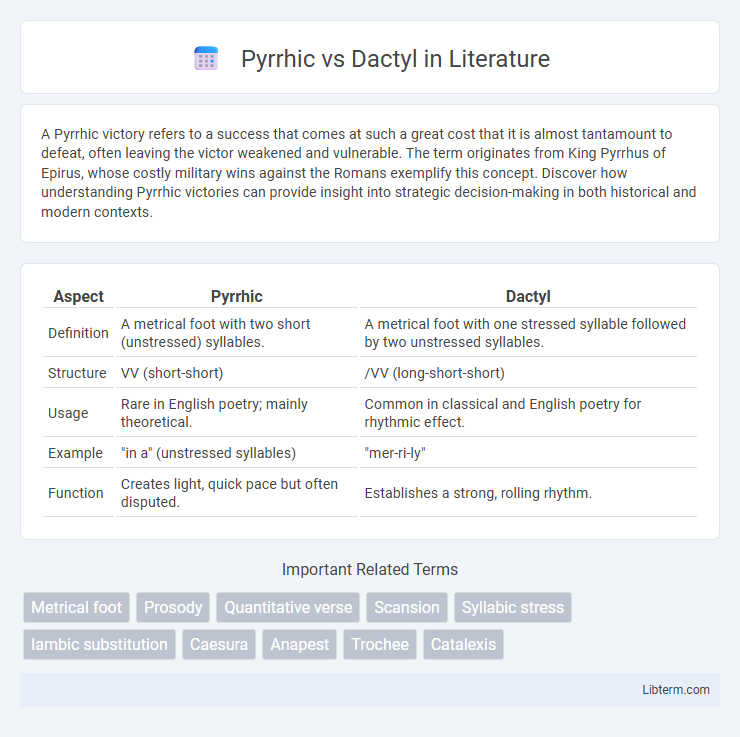A Pyrrhic victory refers to a success that comes at such a great cost that it is almost tantamount to defeat, often leaving the victor weakened and vulnerable. The term originates from King Pyrrhus of Epirus, whose costly military wins against the Romans exemplify this concept. Discover how understanding Pyrrhic victories can provide insight into strategic decision-making in both historical and modern contexts.
Table of Comparison
| Aspect | Pyrrhic | Dactyl |
|---|---|---|
| Definition | A metrical foot with two short (unstressed) syllables. | A metrical foot with one stressed syllable followed by two unstressed syllables. |
| Structure | VV (short-short) | /VV (long-short-short) |
| Usage | Rare in English poetry; mainly theoretical. | Common in classical and English poetry for rhythmic effect. |
| Example | "in a" (unstressed syllables) | "mer-ri-ly" |
| Function | Creates light, quick pace but often disputed. | Establishes a strong, rolling rhythm. |
Introduction to Pyrrhic and Dactyl
Pyrrhic and dactyl are metrical feet used in poetry to create rhythm and meter, with pyrrhic consisting of two unstressed syllables and dactyl comprising one stressed syllable followed by two unstressed syllables. Pyrrhic is rare in English verse and often occurs within larger metrical patterns, while dactyl is common in classical poetry and helps produce a flowing, melodic effect. Understanding the distinction between pyrrhic and dactyl is essential for analyzing poetic structure and enhancing metrical variety.
Defining Pyrrhic Meter
Pyrrhic meter consists of two unstressed syllables, creating a light and swift rhythmic foot rarely used alone in English poetry due to its subtle emphasis. This contrasts with the dactyl, which includes one stressed syllable followed by two unstressed syllables, producing a more pronounced, rolling cadence. Understanding pyrrhic meter is essential for analyzing the nuanced variations in classical and modern verse, as it often appears embedded within larger metrical patterns to add rhythmic diversity.
Understanding Dactylic Meter
Dactylic meter consists of one stressed syllable followed by two unstressed syllables, creating a rhythm often used in classical poetry such as Homeric epics. In contrast, a Pyrrhic foot contains two unstressed syllables, rarely used alone but often appearing in combination with other metrical feet to create rhythmic variation. Mastery of dactylic meter enhances the appreciation of ancient poetic forms and their musicality in verse composition.
Historical Origins and Usage
Pyrrhic and dactyl are metrical feet originating from ancient Greek and Latin poetry, with Pyrrhic consisting of two short syllables and dactyl comprising one long syllable followed by two short syllables. Pyrrhic feet appear less frequently in classical verse, often serving as a subtle rhythmic variation in dactylic hexameter, the meter famously used by Homer and Virgil. Dactyls dominate epic poetry, providing a lively and flowing rhythm that underscores the narrative's grandeur and pace in works such as the Iliad and the Aeneid.
Structural Differences: Pyrrhic vs Dactyl
A Pyrrhic foot consists of two unstressed syllables, creating a light and quick rhythm, whereas a Dactyl contains one stressed syllable followed by two unstressed syllables, establishing a more pronounced and flowing metrical pattern. Structurally, the Pyrrhic's uniform unstressed syllables produce minimal emphasis, contrasting with the Dactyl's clear stress pattern that enhances rhythmic diversity in poetic meter. These differences significantly influence the overall tempo and tone in classical and modern verse compositions.
Examples of Pyrrhic in Poetry
Pyrrhic meters consist of two unstressed syllables, often found in classical poetry as transitions between stronger metric feet. Examples of pyrrhic usage can be identified in lines of Shakespeare's works, such as in "When to the sessions of sweet silent thought," where the subtle unstressed syllables contribute to the rhythmic variation. Pyrrhic feet frequently appear alongside stronger feet like iambs and trochees, adding nuanced flow and complexity to poetic meter.
Examples of Dactyl in Poetry
Dactyl is a metrical foot in poetry consisting of one stressed syllable followed by two unstressed syllables, as seen in the word "beautiful." Examples of dactyls appear prominently in classical epics such as Homer's "Iliad," where the rhythm supports the grandeur and flow of the narrative. Poets like Henry Wadsworth Longfellow also utilized dactylic meter in works like "Evangeline" to create a melodic, rolling effect in their verse.
Effects on Rhythm and Sound
Pyrrhic meter, consisting of two unstressed syllables, creates a subtle, gentle rhythm that often slows the pace and adds a fleeting softness to the sound. In contrast, the dactyl pattern, with one stressed syllable followed by two unstressed syllables, generates a lively, rolling rhythm that energizes the verse and enhances musicality. The interplay between pyrrhic's restraint and dactyl's buoyancy significantly influences a poem's emotional tone and auditory texture.
Common Misconceptions and Controversies
Pyrrhic and dactyl are often misunderstood due to their rhythmic similarities, but a pyrrhic consists of two unstressed syllables, whereas a dactyl has one stressed followed by two unstressed syllables. Common misconceptions arise from the rarity of pyrrhics in English verse, leading some to question their validity as a metrical foot. Controversies also stem from differing interpretations in classical versus modern metrics, where pyrrhics are more prominent in classical poetry but debated in contemporary prosody analysis.
Impact on Modern Poetry
Pyrrhic and dactyl metrical feet significantly influence modern poetry by shaping rhythm and emotional tone. Pyrrhic feet, consisting of two unstressed syllables, create a subtle, flowing effect often used to evoke softness or hesitation. In contrast, dactyls, composed of one stressed syllable followed by two unstressed syllables, generate a lively, melodic rhythm that enhances narrative pace and musicality in contemporary verse.
Pyrrhic Infographic

 libterm.com
libterm.com